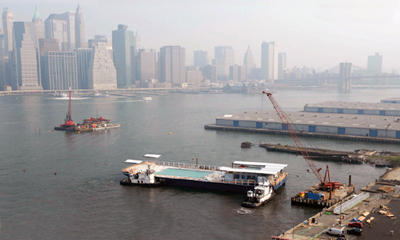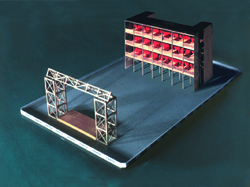You are in: Home page > Magazine Archive > City As Theater
The design work produced in our office over the past 15 years includes social housing, public swimming pools, and (un-built) theater projects. These seemingly disparate project types share a common thread which runs through their conceptual if not physical form: the notion of the urban room as theater.
In each case, whether pool, theater or housing, physically mobile or adaptable to a variety of sites, the spaces of social engagement are privileged throughout these projects. These urban living rooms act to set the table, in Aldo Rossi’s words, for the theater of everyday life.
Leon Battista Alberti
Sean O’Casey
This understanding of theater, at least in the first two instances, is not meant to suggest a theatrical space of performance, or a stage with actors, but more a space of interaction, of chance meetings, where the roles of the observer and the observed are constantly in flux.
Moreover, the pools and mobile theaters are envisioned as public structures which travel physically from place to place, and have a clearly temporal or seasonal element. The housing, on the other hand, typically fixed and rooted to a particular site, is here conceived as a mobile DNA or urban spatial matrix that acts to figure collective spaces, nimble and adaptive to any number of irregular infill sites.
In all three cases there is always implied the questions of permanence and mobility, the passage of time, loss and memory.
Six Housing Projects on Remnant Sites
Supportive housing is a publically-funded hybrid housing type that combines small studio apartments with supportive services - medication-management, counseling, job training. The buildings also include congregate spaces such as libraries, dining rooms and lounges, and exercise rooms. As a primary focus in all of our buildings, the units are organized around exterior courts and gardens that provide safe and attractive gathering spaces, the ‘outdoor rooms’ for the building’s formerly homeless residents.
One of the main challenges, and perhaps the greatest design opportunity, lies in the sites we now find. With the current scarcity of inexpensive lots having wide street frontage, the majority of building sites left to not-for-profit developers and their architects have been the irregular ‘left-over’ parcels: narrow on street frontage and deep in proportion, curved, triangular or trapezoidal in shape, sloping from grade or with rock outcroppings. The high density of the social housing program requires that these buildings be ‘shoe-horned’ into their sites, and the result is a great variation of building forms in spite of a similarity of program. We see it as a ‘case study’ in urban-remnant infill.
Each site condition presented its own puzzle and pleasures. In all six cases plans and sections were constantly tweaked and honed both for maximum efficiencies and spatial effect: ceiling heights compressed and then raised within the unit entry sequence, double-loaded configurations pierced at strategic moments to allow natural light into public corridors and waiting areas, larger scale ‘collective’ figures carved into punched fields of regular openings.
On the technical end, environmentally progressive systems were employed in each building iteration despite their low budget: high performance exterior envelopes with central heating and cooling fan coils, green roofs, gearless elevators, energy efficient lighting and appliances, re-cycled and recyclable materials. The constraints of budget, agency requirements and time schedules, while sometimes challenging and frustrating, have also been liberating. Design solutions need to be simple, strong and clear, and each element must perform double duty and sometimes more.
The Floating Pool
In terms of design, we approached the Floating Pool in the same way we approach any urban project: we chose an organizing form which expressed the essence of the social act of gathering and engagement. Here, we created a sun court, a generous public space enclosed on three sides and open to the pool and view on the fourth. Health Department requirements for entry, changing and showering acted to structure a meandering sequence through the variety of pool program pieces, each bounded by clapboard-skinned cabins with open-air skylights. Coming up with the design and assembling the engineering team -marine mechanical and structural engineers, a pool consultant, mooring and subsurface engineers, code consultants and construction managers- turned out to be the easy part.
The challenges were many over the next six years: locating a decommissioned river barge of the right dimensions with minimal rust, the rising cost of steel , re-designs and changes in detailing to match ship-building techniques. Meanwhile, regulatory approvals kept mounting, from the Army Corps of Engineers to the Coast Guard, from the Building Department to the Department of Homeland Security. And finally added to the fund-raising difficulties in the aftermath of the dot-com crisis was the unforeseen Hurricane Katrina, which set construction back by more than a year.
Our perseverance however paid off. The Floating Pool was tugged into place at Pier 4 along the Brooklyn waterfront in early summer of 2007. After an all-nighter (we had to pass the final Health Department inspection the same morning the Pool opened to the public) I remember wearily but happily watching from one of the shading pavilions as the first group of kids streamed across the 90’ gangways into the court, through the changing rooms and down the long ramps to the pool deck. We had a part in making a new social space for NYC children and this made the seven-year struggle worthwhile.
Now, seven years later, with the Floating Pool serving 1000 children per day during the summer months in Hunts Point, Bronx, we have been commissioned to design a second floating pool for Brooklyn Bridge Park, scheduled to open for summer 2016.
Three Theater Projects
The three theater projects describes here are variations on a theme, each with different clients and sites. The design theme centers on the repetition of cellular viewing boxes, defining the collective space of the theater-house through the use of discreet spaces along its edges. The development of the linear or curvilinear ‘bar’ scheme was an investigation into the dual role of the structure as skene (scene) building and as seating structure, challenging the traditional notions of the space of viewer and performer.
The design of the Music Mountain performance center was to expand the student facilities of the oldest chamber music festival in the US. The site for the new center is along a heavily wooded hill which rises behind the existing campus of loosely organized 1930's Sear's Kit buildings in Falls Village, Connecticut. The new multi-functioning building serves as temporary living quarters, practice studios, and box seating for the music students attending a series of two-week summer sessions. Each 9' x 10' living unit in the arc contains a pull-down bed, closet and large casement window opening to an unobstructed view of the stage, and functions as practice room during the day, bedroom at night, and viewing box during performances. Bathrooms and showers are located at the arc extremities, as are the round stair towers. The stage building accommodates a variety of performance requirements: flaps are hinged out for 'band-shell' use, or are slid back to create a deep space for dance and theater. When not used for performances, the backstage area functions as dining room with adjacent warming pantry. Modular construction would comprise a glue-lam system, tongue-and-groove wood siding and plank floors.
The demountable theater seating structure for Castle Clinton in Battery Park, NYC was commissioned by the Conservancy for Battery Park and the National Park Service. The original stone fortification, erected in 1808, was roofed over in 1824 and used as a public concert hall; the unroofed fort now serves as an information center and site for informal outdoor events. The new open-air theater is comprised of a three-story arc of steel scaffold theater boxes inserted within the castle walls and rising 20 feet above. The skeletal seating arc set opposite a small stage creates a more formal theatrical space while increasing capacity by 400. A viewing platform oriented towards New York Harbor is suspended over the Castle walls, as are the two stair towers which provide additional access to the boxes.
The Floating Theater, the precursor to the Floating Pool, is conceived as a temporary outdoor film and performance venue built on a floating deck barge. The barge would be moored at different locations around Manhattan over the course of several summers. The focus of this 600-seat venue is a four-story seating structure comprised of open-air 'theater boxes' which face the stage and projection screen. This seating structure is made from a steel scaffolding system, plank decking, and fabric curtains. The balance of viewer seating is on folding chairs set on the barge deck itself, allowing this area to be cleared at other times for events, dances, and exhibitions.
In each case, whether pool, theater or housing, physically mobile or adaptable to a variety of sites, the spaces of social engagement are privileged throughout these projects. These urban living rooms act to set the table, in Aldo Rossi’s words, for the theater of everyday life.
Jonathan Kirschenfeld Architect PC is internationally recognized for design excellence over a wide range of environmentally- and socially-sustainable projects, with exceptionally strong credentials in the areas of supportive housing, childcare centers, recreation and performance facilities.
Mr. Kirschenfeld’s firm is best known for its large-scale conversion and re-purposing of a cargo vessel into the Floating Pool. The complex hosted over 50,000 visitors during its first eight week season in Brooklyn and now serves up to 1,200 swimmers daily at its Hunt’s Point, Bronx location.
Kirschenfeld recently founded the Institute for Public Architecture (IPA), a not-for-profit organization promoting socially engaged architecture through urban research projects and a residency program for design practitioners.
















